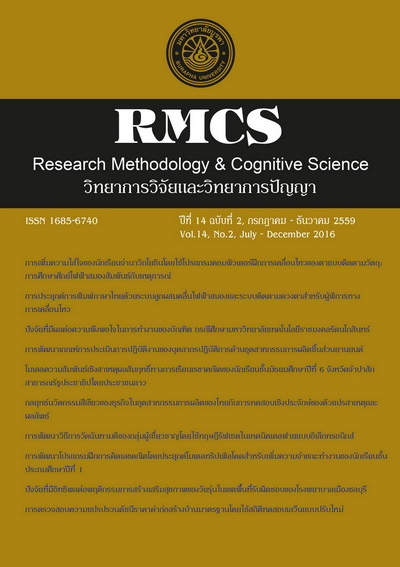การพัฒนาเกณฑ์การประเมินการปฏิบัติงานของบุคลากรปฏิบัติการด้านอุตสาหกรรมการผลิตชิ้นส่วนยานยนต์
Main Article Content
Abstract
การวิจัยนี้มีวัตถุประสงค์เพื่อพัฒนาเกณฑ์การประเมินการปฏิบัติงานของบุคลากรปฏิบัติการด้านอุตสาหกรรมการผลิตชิ้นส่วนยานยนต์ด้วยเทคนิคเดลฟายแบบอิเล็กทรอนิกส์จำนวน 3 รอบกับผู้เชี่ยวชาญจำนวน 19 คนและจัดลำดับองค์ประกอบและตัวบ่งชี้ด้วยกระบวนการลำดับชั้นเชิงวิเคราะห์ พัฒนาโปรแกรมคอมพิวเตอร์แบบออนไลน์ด้วยโปรแกรม PHP เปรียบเทียบค่าเฉลี่ยคะแนนการประเมินการปฏิบัติงานของบุคลากรปฏิบัติการระหว่างวิธีการให้คะแนนแบบฟัซซีกับวิธีการให้คะแนนแบบถ่วงน้ำหนัก และเปรียบเทียบผลการประเมินการปฏิบัติงานของบุคลากร
ปฏิบัติการด้านอุตสาหกรรมการผลิตชิ้นส่วนยานยนต์ระหว่างองค์การที่ได้รับมาตรฐานคุณภาพ ISO 9001 กับองค์การที่ได้รับมาตรฐานคุณภาพ ISO/TS 16949 วิเคราะห์ค่าสถิติด้วยสถิติทดสอบแมน-วิทนีย์ ยู ผลการวิจัยปรากฏว่า
1. เกณฑ์การประเมินการปฏิบัติงานของบุคลากรปฏิบัติการด้านอุตสาหกรรมการผลิตชิ้นส่วนยานยนต์ ประกอบด้วย 7 ด้าน (21 ตัวบ่งชี้) ได้แก่ 1) ด้านทักษะและประสบการณ์ 2) ด้านปัญญา 3) ด้านการจัดการความสัมพันธ์ และการทำงานร่วมกัน 4) ด้านลักษณะส่วนบุคคล 5) ด้านบรรลุเป้าหมาย 6) ด้านภาวะผู้นำและ 7) ด้านความคิดสร้างสรรค์และการปรับเปลี่ยนความคิด เกณฑ์ฯ สามารถจำแนกระดับการปฏิบัติงานของบุคลากรปฏิบัติการออกเป็น 5 ระดับตั้งแต่ระดับที่ 1 (ต้องปรับปรุง) ถึงระดับที่ 5 (ดีเด่น)
2. โปรแกรมคอมพิวเตอร์ประเมินการปฏิบัติงานของบุคลากรปฏิบัติการด้านอุตสาหกรรมการผลิตชิ้นส่วนยานยนต์แบบออนไลน์ที่พัฒนาขึ้นมีความเหมาะสมที่จะนำไปใช้งาน
3. ผลการเปรียบเทียบค่าเฉลี่ยคะแนนการประเมินการปฏิบัติงานของบุคลากรปฏิบัติการระหว่างวิธีการให้คะแนนแบบฟัซซีกับวิธีการให้คะแนนแบบถ่วงน้ำหนัก ปรากฏว่าไม่มีความแตกต่างกันทางสถิติ
4. ผลการเปรียบเทียบการประเมินการปฏิบัติงานของบุคลากรปฏิบัติการด้านอุตสาหกรรมการผลิตชิ้นส่วนยานยนต์ขององค์การที่ได้รับมาตรฐานคุณภาพ ISO 9001กับองค์การที่ได้รับมาตรฐานคุณภาพ ISO/TS 16949 ปรากฏว่ามีความแตกต่างกันอย่างมีนัยสำคัญทางสถิติที่ระดับ .01
สรุปได้ว่าเกณฑ์การประเมินการปฏิบัติงานมีความเหมาะสมที่จะนำไปใช้ในการประเมินบุคลากรปฏิบัติการด้านอุตสาหกรรมการผลิตชิ้นส่วนยานยนต์
The objectives of this research were (1) to develop criteria for assessing employee performance in the automotive parts industry using a modified Three Round e-Delphi procedure involving nineteen experts; (2) to rank the developed components with Analytic Hierarchy Process (AHP); (3) to develop an online program using PHP; (4) to compare the average criteria scoring between the fuzzy logic model and the weighted sum model; and (5) to compare the results of criteria for assessing employee performance in automotive parts industry that have received ISO 9001 quality and ISO/TS 16949 quality. Data were analyzed using Mann-Whitney U test. The results were as follows:
1. The developed criteria for assessing employee performance in automotive parts industry consisted of seven components with twenty-one indicators. The components were (1) skills and experience; (2) cognitive domain; (3) interpersonal and collaboration skills; (4) trait; (5) achievement; (6) leadership; (7) creative and adaptive thinking. Assessing employee performance was categorized into five levels from 1 (strongly needing improvement) to 5 (excellent).
2. The developed online program for assessing employee performance in automotive parts industry was accepted by users.
3. The average scoring assessing employee performance between the fuzzy logic model and the weighted sum model had no statistically-significant difference.
4. The assessing employee performance between of organizations received ISO 9001 quality and ISO/TS 16949 quality was found to be statistically significant at the .01 level.
The results confirm that the developed criteria are suitable for assessing employee performance in the automotive parts industry.
Article Details
References
กอบชัย สังสิทธิสวัสดิ์. (2557). กสอ.ปั้นไทยสู่ฮับฐานการผลิตรถยนต์เล็งเพิ่มมูลค่าอุตฯ 5-8%.วันที่ค้นข้อมูล 5 มีนาคม 2558, เข้าถึงได้จาก ้http://www.manager.co.th/iBizChannel/ViewNews.aspx?NewsID=9570000047280
ชูชัย สมิทธิไกร. (2556). การสรรหา การคัดเลือก และการประเมินผลการปฏิบัติงานของบุคลากร. (พิมพ์ครั้งที่ 4).กรุงเทพฯ: สำนักพิมพ์แห่งจุฬาลงกรณ์มหาวิทยาลัย.
บัญญัติ ศิริปรีชา. (2554). ประชาคมเศรษฐกิจอาเซียนกับการคุ้มครองแรงงานในอนาคต. กลุ่มงานมาตรฐานแรงงานระหว่างประเทศ. วันที่ค้นข้อมูล 28 มีนาคม 2558, เข้า
ถึงได้จาก http://www.labour.go.th
ปุณฑริก สมิติ. (2557). เผยอุตสาหกรรมยานยนต์ต้องการแรงงานอีกเพียบ.วันที่ค้นข้อมูล 28 มีนาคม 2558, เข้าถึงได้จาก http://www.matichon.co.th/news_detail.
php? newsid=1416455886
ประมา ศาสตระรุจิ. (2550). การพัฒนาเกณฑ์สมรรถนะในการประเมินผลการปฏิบัติงานของผู้บริหารศูนย์เทคโนโลยีทางการศึกษา สำานักบริหารงานการศึกษานอกโรงเรียน.
วันที่ค้นข้อมูล 30 มกราคม 2559, เข้าถึงได้จาก https://library.ipst.ac.th/archive/handle/ipst/412
สถาบันยานยนต์. (2555). แผนแม่บทอุตสาหกรรมยานยนต์ ปี พ.ศ. 2555-2559. กรุงเทพฯ. กระทรวงอุตสาหกรรม. ม.ป.ท.
สำนักงานรางวัลคุณภาพแห่งชาติ. (2556). เกณฑ์รางวัลคุณภาพแห่งชาติปี 2557-2558. กรุงเทพฯ: แกรนด์อารต์ ครีเอทีฟ.
สำราญ มีแจ้ง และสมหวัง พิธิยานุวัฒน์. (2558). การประเมินผลการปฏิบัติงานแนวใหม่: ทฤษฎีและปฏิบัติ. (พิมพ์ครั้งที่ 2). กรุงเทพฯ: โรงพิมพ์แห่งจุฬาลงกรณ์มหาวิทยาลัย.
Aimin, Y., & Barbara G. (2001). Bargaining Power. Management control, and performance in US China Joint Wentures: A comparative case study. Academy of Management Journal, 37(6), 1478-1517.
Alpkan, L., Bulut, C., Gunday, Ulusoy, G., & Kilic, K. (2010). Organizational support for intrapreneurship and its interaction with human capital to enhance innovative performance. Management Decision, 48(5-6), 732-755.
CARL (2010). Core competencies for 21stCentury CARL Librarians. Canadian Association of Research Libraries.
Davidz, H.L., & Nightingale, D.J. (2008). Enabling systems thinking to accelerate the development of senior systems engineers. INCOSE Journal of Systems Engineering, 11(1), 1-14.
Edmonds, W. A., & Kennedy, T. D. (2013). An applied reference guide to research designs: Quantitative, qualitative, and mixed methods. Thousand Oaks, California: Sage Publications.
Fang, V. W., Tian, X., & Tice, S. (2014). Does stock Liquidity enhance or impede firm innovation. The Journal of finance, 69(5), 2085-2125.
Florida, R., Mellander, C., & Stolarick, K. (2008). Inside the black box of regional development human capital, the creative class and tolerance. Journal of Economic Geography, 8(5), 615-649.
Frank, M. (2012). Engineering systems thinking: Cognitive competencies of successful systems engineers. Procedia Computer Sciences, 8, 273–278.
Golec, A., & Kahya, E. (2007). A fuzzy model for competency-based employee evaluation and selection. Computers & Industrial Engineering, 52, 143-161.
IFTF. (2011). Future work skills. Institute for the Future for University of Phoenix Research Institute. California. Retrieved February 17, 2014 from http://cdn.theatlantic.com/static/front/docs/sponsored/
phoenix/future_work_skills_2020.pdf
Kasser, J. E., & Frank, M. (2011). Systems Engineering – Practice and Theory: Assessing The Capacity for Engineering Systems Thinking (CEST) and Other Competencies of Systems Engineers, Systems
Engineering – Practice and Theory, Prof. Boris Cogan (Ed.).Retrieved June 24, 2011 from http://www.intechopen.com/books/systems-engineeringpractice-and-theory/assessing-the-capacity-forengineering-systems-thinking-cest-and-othercompetencies-of-systems-engin
Nachar, N. (2008). The Mann-Whitney U: A test for assessing whether two independent samples come from the same distribution. Tutorials in
Quantitative Methods for Psychology, 4(1), 13-20.
NASA. (2009). Systems engineering competencies. Retrieved June 24, 2011 from: http://www.nasa.gov/pdf/303747main_Systems_Engineering_Competencies.pdf
Ngai, E. W. T., & Wat, F. K. T. (2004). Human resource information systems: a review and empirical analysis. Personal Review, 35(3), 297-314.
Rothwell, W.J., & Graber, J.M. (2010). Competency-Based Training Basics.The United State of America: Versa Press Inc.
Ruzzier, M., Antoncic, B., Hisrich, R. D., & Konechnil, M. (2007). Human capital and SME internationalization: A structural equation modeling study. Canadian Journal of Admininistrative sciences, 24(1), 15-29.
Schumacker, R.E., & Lomax, R.G. (2004). A Beginner’s Guide to Structural Equation Modeling (2nded.). The United State of America: Lawrence Erlbaum Associates.
Thongchai, P., Kornpetpanee, S., & Sripunvoraskul, S. (2012).The Development of Criteria for Selecting Research Consultants. Research Methodology & Cognitive Science, 9(2), 30-40.
Van de Ven, A. H., Angle, H. A., & Poole, M. S. (eds) (1989). Research on the management of innovation: the Minnesota studies. New York: Ballinger/Haper and Row.
Vashishth, M. (2014). Role of IT in HRM: Opportunities and Challenges. Indian Journal of Resesearch,3(4), 159-160.
Wiersma, W., & Jurs, S.G. (2009). Research methods in education: an introduction(9thed.). Boston: Pearson.
Zhu, W., Chew, K.H., & Spangler, W.D. (2005). CEO transformational leadership and organizational outcomes: The mediating role of human-capitalenhancing human Resource management. The Leadership Quarterly, 16(1), 39-52.

